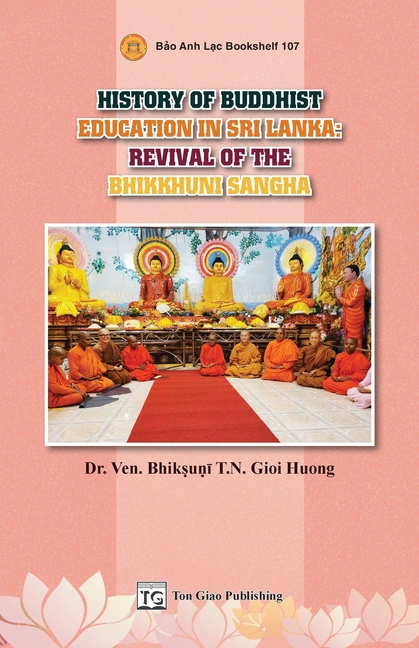Description
It is with profound gratitude that I write these few words for this booklet titled History of Buddhist Education in Sri Lanka: Revival of the Bhikkhuni Sangha. This work is a significant contribution to the field of Buddhist studies, and I would like to express my deep appreciation to Venerable Dr. Bhikṣuṇī T.N. Giới Hương, President, Huong Sen Buddhist Temple, California, USA, for her unwavering commitment to preserving and promoting the rich heritage of Buddhism in Sri Lanka. Her dedication is reflected not only in this publication but also in her numerous other works in Bao Anh Lac Bookshelf (Huong Sen Buddhist Temple) and her active participation in the academic and spiritual life of Sri Lankan Buddhism.
Dr. Bhikkhuni T.N. Giới Hương has frequently visited Sri Lanka, India, and other Buddhist countries, demonstrating her enthusiasm for the Theravada Buddhist tradition and the culture which is based on Buddhist teachings. She has made significant contributions by organizing academic Buddhist conferences in 2023 at prestigious institutions such as the Universities of Sharda, Uttar Pradesh and Siddharth United Social Welfare Mission, Chinar Park, Kolkata (India), Peradeniya (Kandy), and Colombo (Sri Lanka). Through these initiatives, she has effectively committed herself to promoting Sri Lankan and Indian Buddhism, both within the country and on a global scale.
Sri Lanka, often referred to as the "Pearl of the Indian Ocean," boasts a long and rich history of Buddhist education that dates back to the third century BCE. This booklet thoroughly details the development of Buddhist education in Sri Lanka, beginning with the early monastic schools known as 'Pirivena' and extending through the ancient, medieval, and colonial eras. Buddhist education has played a crucial role in shaping the cultural and spiritual identity of the nation, ensuring the transmission of knowledge and ethical values across generations.
This booklet delves deeply into the most prominent universities and institutes of Buddhist studies in Sri Lanka, such as the Buddhist and Pali University in Homagama and the Sri Lanka Bhikshu University in Anuradhapura. These institutions have been leaders in Buddhist scholarship, fostering generations of monks, nuns, and laypeople in their pursuit of spiritual and academic excellence. The booklet's comprehensive descriptions of forest monasteries, meditation centers, and bhikkhuni education centers emphasize the ongoing vitality and relevance of Sri Lankan Sangha (Monks and Nuns).
The history of the revival of the Bhikkhuni Sangha in Sri Lanka, as mentioned in this booklet, is particularly noteworthy. The establishment of bhikkhuni education centers and their substantial contributions to both local and international Buddhist communities demonstrate the resilience and adaptability of Buddhist education in Sri Lanka. The stories of pioneering bhikkhunis, such as Venerable Bhikkhuni Kusuma and Venerable Bhikkhuni Peliyagoda Sudarshana..., powerfully illustrate the enduring spirit of Buddhist Nuns and its ability to inspire and empower.
I believe this booklet will be a highly valuable resource for anyone interested in the history and current state of Buddhist education in Sri Lanka. It not only provides a wealth of information but also offers insights into the lasting impact of Buddhist teachings on the cultural and spiritual lif e of the Ceylon island nation. I wholeheartedly recommend this work to scholars, practitioners, and all those who seek to deepen their understanding of Buddhism in Sri Lanka.
May this publication inspire many to explore and appreciate the profound heritage of Buddhist education in Sri Lanka, and may it contribute to the continued flourishing of the Dhamma nationally and internationally in every school of Buddhism.
(Foreword - Ven. Dr. K. Siri Sumedha Thero)
Product Details
- Jul 7, 2025 Pub Date:
- 9798349478000 ISBN-10:
- 9798349478000 ISBN-13:
- English Language




